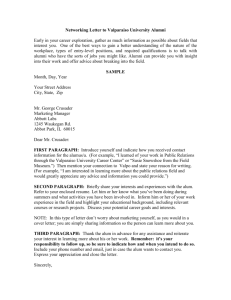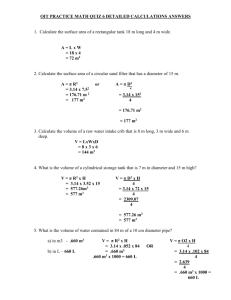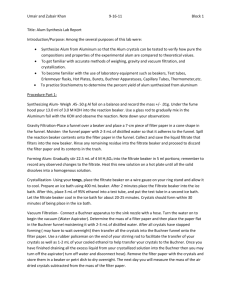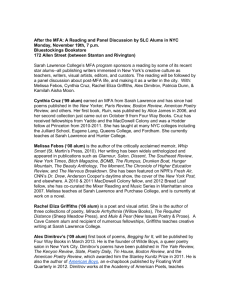PREPARATION AND VERIFICATION OF ALUM
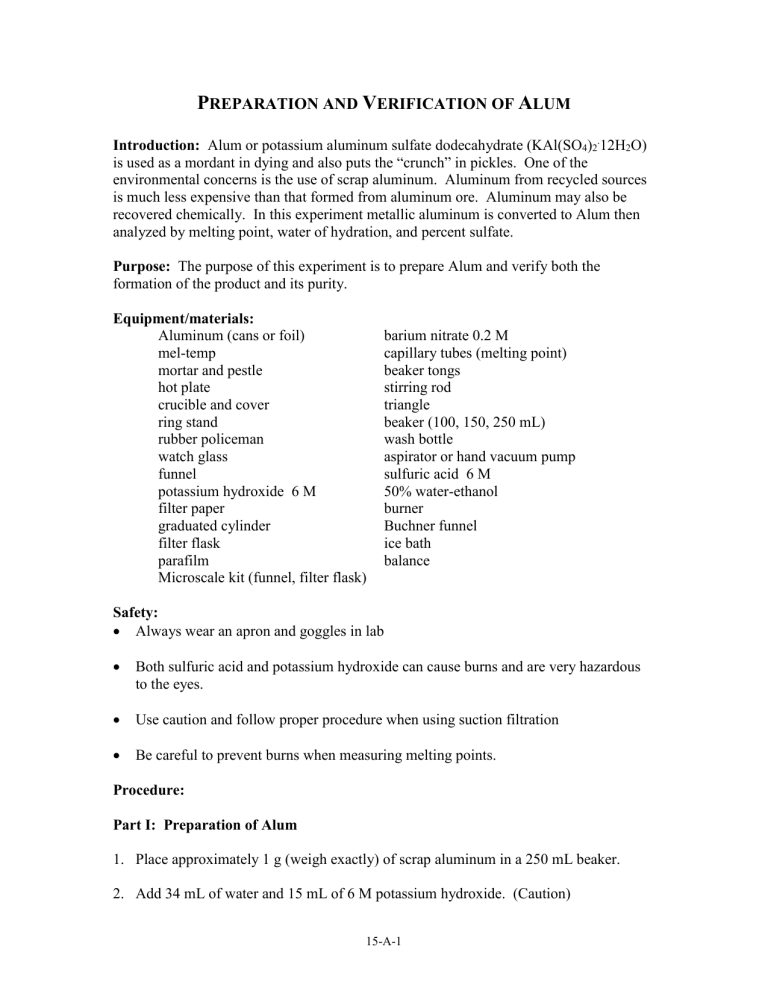
P
REPARATION AND
V
ERIFICATION OF
A
LUM
Introduction: Alum or potassium aluminum sulfate dodecahydrate (KAl(SO
4
)
2
.
is used as a mordant in dying and also puts the “crunch” in pickles. One of the
12H
2
O) environmental concerns is the use of scrap aluminum. Aluminum from recycled sources is much less expensive than that formed from aluminum ore. Aluminum may also be recovered chemically. In this experiment metallic aluminum is converted to Alum then analyzed by melting point, water of hydration, and percent sulfate.
Purpose: The purpose of this experiment is to prepare Alum and verify both the formation of the product and its purity.
Equipment/materials:
Aluminum (cans or foil) mel-temp hot plate mortar and pestle crucible and cover ring stand rubber policeman barium nitrate 0.2 M capillary tubes (melting point) beaker tongs stirring rod triangle beaker (100, 150, 250 mL) wash bottle watch glass funnel potassium hydroxide 6 M filter paper graduated cylinder filter flask parafilm aspirator or hand vacuum pump sulfuric acid 6 M
50% water-ethanol burner
Buchner funnel ice bath balance
Microscale kit (funnel, filter flask)
Safety:
Always wear an apron and goggles in lab
Both sulfuric acid and potassium hydroxide can cause burns and are very hazardous to the eyes.
Use caution and follow proper procedure when using suction filtration
Be careful to prevent burns when measuring melting points.
Procedure:
Part I: Preparation of Alum
1.
Place approximately 1 g (weigh exactly) of scrap aluminum in a 250 mL beaker.
2.
Add 34 mL of water and 15 mL of 6 M potassium hydroxide. (Caution)
15-A-1
3.
Heat very gently on a hot plate with all flames extinguished. (Use hood if available)
4.
Continue heating until all of the aluminum has reacted and until no more gas bubbles are formed.
5.
Remove from heat and allow to cool to room temperature.
6.
Filter to remove any solid particles.
7.
Collect the clear liquid in a clean 150 mL beaker.
8.
Use a wash bottle to rinse all of the solution out of the 250 mL beaker.
9.
Filter the wash water, collecting the clear liquid in the same 150 mL beaker.
10.
Acidify the solution by adding 6 M sulfuric acid slowly with stirring (Caution). The solution will get very hot (why?). Solid Al(OH)
3
will first precipitate and then dissolve as more sulfuric acid is added. Continue to add sulfuric acid until all of the precipitate dissolves. (If any solid remains, the solution must be filtered).
11.
Boil the solution to reduce volume about 50%.
12.
Cool the solution in an ice bath.
13.
Cover and allow the solution to remain undisturbed until crystals form. If no crystals form, scrape the bottom of the beaker with a stirring rod.
14.
Determine the mass of the filter paper.
15.
Collect the crystals by vacuum filtration.
16.
Wash the crystals with 50 mL of 50% ethanol-water.
17.
Allow the crystals to dry.
18.
Determine the mass of the filter paper and dry alum.
19.
Determine the mass of alum.
20.
Calculate the % yield.
15-A-2
Part II
Analysis of Alum
A: Melting point
1.
Pulverize a small amount of alum using a mortar and pestle.
2.
Pack a melting point capillary
3.
Use the mel-temp to determine the melting point.
B: Water of Hydration
1.
Heat dry a crucible and cover.
2.
Determine the mass of the crucible and cover.
3.
Add about 2 g of alum crystals.
4.
Determine the mass of the crucible, cover, and crystals.
5.
Heat the crucible, cover, and alum gently. The alum will melt, and the water of hydration will vaporize.
6.
After the vapor is apparently driven off, heat more intensely for five minutes.
7.
Cool and find the mass of the crucible, cover, and anhydrous alum.
C: Percent sulfate in alum
1.
Obtain a clean, dry microscale Hirsh funnel.
2.
Weigh about 1 g of alum (record exact mass) into a 100 mL beaker.
3.
Dissolve in approximately 50 mL of distilled water.
4.
Calculate the volume of 0.2 M barium nitrate. This will be needed to completely precipitate all of the sulfate ions present in the solution. Then add twice this volume of barium nitrate slowly, while stirring.
5.
Cover the beaker with a watch glass and heat the solution nearly to boiling. Keep the solution just below the boiling point for 15 minutes.
6.
Allow to cool slightly, cover with parafilm, and allow the precipitate to stand overnight.
7.
Record the mass of the Hirsh funnel
15-A-3
8.
Filter the precipitate through the Hirsh funnel. Use a rubber policeman to be sure that all of the precipitate has been transferred from the beaker to the funnel.
9.
Wash the beaker and precipitate several times with small quantities of distilled water.
10.
Allow the Hirsh funnel and precipitate to dry completely.
11.
Determine the mass of funnel and precipitate.
15-A-4
P
REPARATION AND VERIFICATION OF
A
LUM
Data Table:
Mass of Aluminum used _______________ g
_______________ g Mass of Alum formed
Theoretical mass of Alum
Percent yield
Accepted melting point of alum
Experimental melting point of alum
Mass of crucible and cover
Mass of crucible, cover, and alum before heating
Mass of crucible, cover, and anhydrous alum
Mass of anhydrous alum
Moles of anhydrous alum
Mass of water lost
Moles of water lost
Moles of water lost per mole of alum
Mass of dry Hirsh funnel
Mass of Hirsh funnel and dry product (barium sulfate)
Mass of barium sulfate
Mass of sulfate in alum
Percent sulfate in alum
Accepted percent sulfate in alum
_______________ g
_______________ g
_______________ C
_______________ C
_______________ g
_______________ g
_______________ g
________________ g
_______________
_______________ g
_______________
_______________
_________________ g
________________ g
________________ g
_________________ g
_________________ g
_________________ g
15-A-5
Calculations:
1.
Calculate the theoretical mass of alum which could be formed from the mass of
Aluminum used.
2.
Calculate the percent error in the melting point.
3.
Calculate the moles of anhydrous alum
4.
Calculate the moles of water lost
5.
Calculate the moles of water per mole of alum
6.
Calculate the mass percent of sulfate in barium sulfate.
7.
Calculate the mass of sulfate in the alum
8.
Calculate the percent sulfate in the alum.
15-A-6
Questions:
1.
Why did the solution become hot when the sulfuric acid was added?
2.
Name and explain 3 factors that would cause an experimental melting point to be lower than the literature value.
3.
If the alum were not dry, what would be the effect on the experimental formula?
4.
If some of the alum were carried away in the vapor, what would be the effect on the experimental formula?
5.
If some of the barium sulfate precipitate passed through the filter, how will that affect the results?
15-A-7

